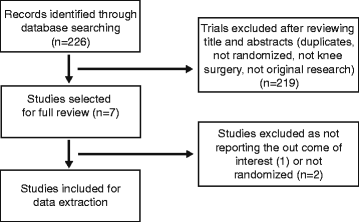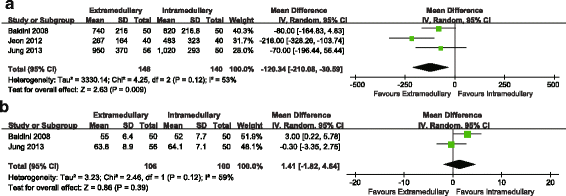Extramedullary versus intramedullary femoral alignment technique in total knee arthroplasty: a meta-analysis of randomized controlled trials
- PMID: 28583144
- PMCID: PMC5460512
- DOI: 10.1186/s13018-017-0582-3
Extramedullary versus intramedullary femoral alignment technique in total knee arthroplasty: a meta-analysis of randomized controlled trials
Abstract
Background: There is no consensus whether the use of the extramedullary femoral cutting guide takes advantage over the intramedullary one in total knee arthroplasty. The aim of this study was to compare the extramedullary femoral alignment guide system with the conventional intramedullary alignment guide system for lower limb alignment, blood loss, and operative time during total knee arthroplasty.
Methods: The Medline, Embase, Cochrane Library, China National Knowledge Infrastructure (CNKI), Wan Fang Chinese Periodical, Google, and reference lists of all the included studies were searched for randomized controlled trials. The following parameters were compared between the extramedullary technique and the intramedullary technique: (1) lower limb coronal alignment, (2) coronal alignment of femoral component, (3) sagittal alignment of femoral component, (4) blood loss, (5) and operation time.
Results: Four randomized controlled trials consisting of 358 knees were included in our study. There was no significant difference between the extramedullary and intramedullary groups for the lower limb coronal alignment (RR = 1.20, 95%CI 0.28~5.21, n.s.), coronal alignment of femoral component (RR = 0.65, 95%CI 0.19~2.22, n.s.), and sagittal alignment of femoral component (RR = 0.73, 95%CI 0.38~1.41, n.s.). A reduced blood loss was associated with the use of the extramedullary guide (MD = -120.34, 95%CI -210.08~-30.59, P = 0.009). No significant difference in operation time was noted between the two groups (MD = 1.41, 95%CI -1.82~4.64, n.s.).
Conclusions: Neither extramedullary nor intramedullary femoral alignment is more accurate than the other in facilitating the femoral cut in total knee arthroplasty. Use of the extramedullary guide results in less blood loss and exhibits a similar operation time as compared with the intramedullary guide.
Keywords: Blood loss; Meta-analysis; Total knee arthroplasty.
Figures





Similar articles
-
Computer-assisted techniques versus conventional guides for component alignment in total knee arthroplasty: a randomized controlled trial.J Bone Joint Surg Am. 2011 Aug 3;93(15):1377-84. doi: 10.2106/JBJS.I.01321. J Bone Joint Surg Am. 2011. PMID: 21915542 Clinical Trial.
-
Comparison of intramedullary versus extramedullary alignment technique in total knee arthroplasty: A PRISMA-compliant meta-analysis.Medicine (Baltimore). 2023 Feb 3;102(5):e32277. doi: 10.1097/MD.0000000000032277. Medicine (Baltimore). 2023. PMID: 36749264 Free PMC article.
-
Intramedullary versus extramedullary alignment guides on total knee arthroplasty: a meta-analysis.J Comp Eff Res. 2018 Dec;7(12):1181-1193. doi: 10.2217/cer-2018-0064. Epub 2018 Nov 28. J Comp Eff Res. 2018. PMID: 30484699
-
Patient-specific instrumentation improved axial alignment of the femoral component, operative time and perioperative blood loss after total knee arthroplasty.Knee Surg Sports Traumatol Arthrosc. 2019 Apr;27(4):1083-1095. doi: 10.1007/s00167-018-5256-0. Epub 2018 Oct 30. Knee Surg Sports Traumatol Arthrosc. 2019. PMID: 30377714 Free PMC article. Review.
-
Shorter survival rate in varus-aligned knees after total knee arthroplasty.Knee Surg Sports Traumatol Arthrosc. 2016 Aug;24(8):2663-71. doi: 10.1007/s00167-015-3781-7. Epub 2015 Sep 16. Knee Surg Sports Traumatol Arthrosc. 2016. PMID: 26377095 Review.
Cited by
-
A novel extramedullary technique to guide femoral bone preparation in mobile unicompartmental knee arthroplasty based on tibial cut and overall alignment.J Orthop Surg Res. 2020 Mar 5;15(1):92. doi: 10.1186/s13018-020-01598-6. J Orthop Surg Res. 2020. PMID: 32138759 Free PMC article.
-
A New Concept of Using Femoral Condyles Surface for Femoral Component Alignment During Total Knee Arthroplasty: A Technical Note.Indian J Orthop. 2023 Nov 15;57(12):2088-2094. doi: 10.1007/s43465-023-01023-0. eCollection 2023 Dec. Indian J Orthop. 2023. PMID: 38009183 Free PMC article.
-
The Effect of Intramedullary vs Extramedullary Tibial Guides on the Alignment of Lower Extremity and Functional Outcomes Following Total Knee Arthroplasty: A Randomized Clinical Trial.Arch Bone Jt Surg. 2023;11(7):441-447. doi: 10.22038/ABJS.2022.60061.2960. Arch Bone Jt Surg. 2023. PMID: 37538133 Free PMC article.
-
TKA with retained hardware guided by intraoperative ultrasonography - a case report.BMC Surg. 2019 Sep 2;19(1):126. doi: 10.1186/s12893-019-0585-6. BMC Surg. 2019. PMID: 31477077 Free PMC article.
-
Blood management in fast-track orthopedic surgery: an evidence-based narrative review.J Orthop Surg Res. 2019 Aug 20;14(1):263. doi: 10.1186/s13018-019-1296-5. J Orthop Surg Res. 2019. PMID: 31429775 Free PMC article. Review.
References
-
- Fujimoto E, Sasahige Y, Tomita T, Kashiwagi K, Inoue A, Sawa M, et al. Different femorotibial contact on the weight-bearing: midflexion between normal and various aligned knees after total knee arthroplasty. Knee Surg Sports Traumatol Arthrosc. 2015;23:1720–8. doi: 10.1007/s00167-014-3194-z. - DOI - PubMed
-
- Brys DA, Lombardi AV, Jr, Mallory TH, Vaughn BK. A comparison of intramedullary and extramedullary alignment systems for tibial component placement in total knee arthroplasty. Clin Orthop Relat Res. 1991;263:175–179. - PubMed
Publication types
MeSH terms
LinkOut - more resources
Full Text Sources
Other Literature Sources
Medical
Miscellaneous

